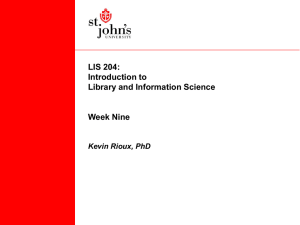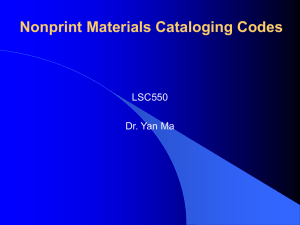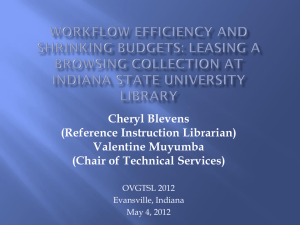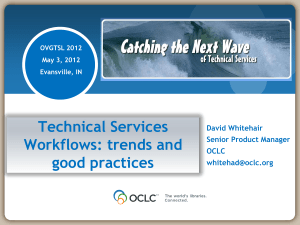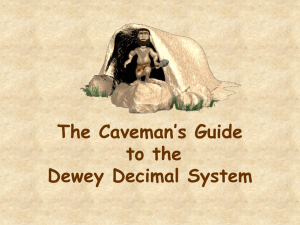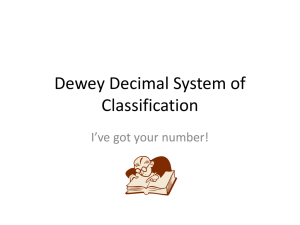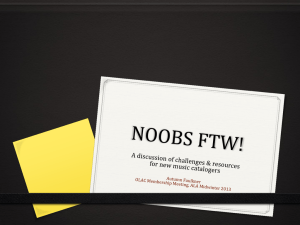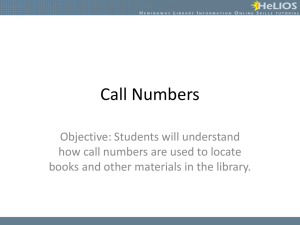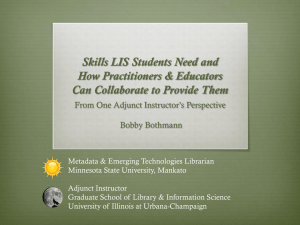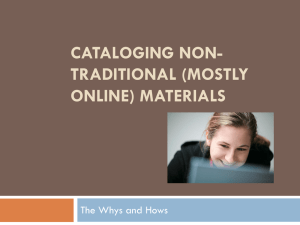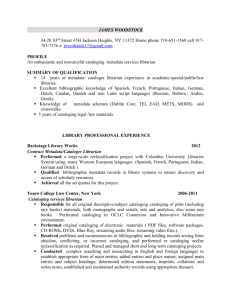IMD 253 cpt.4 ORGANIZING OF LIBRARY MATERIALS
advertisement
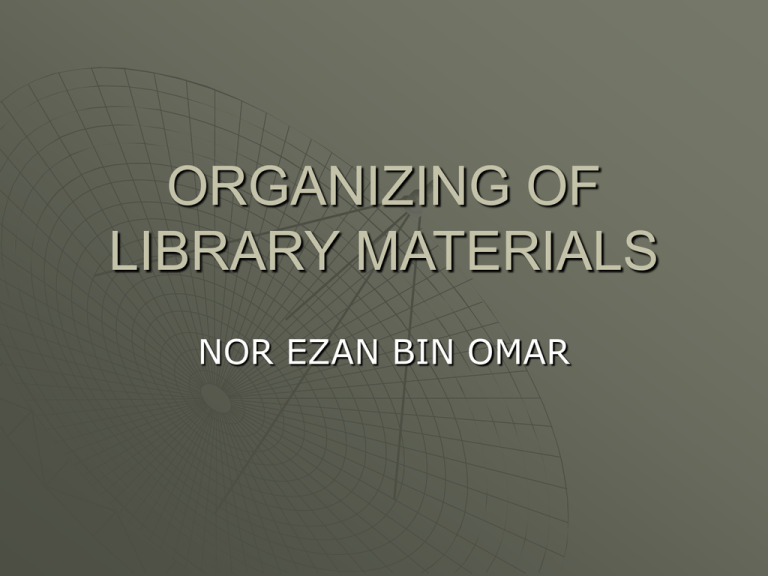
ORGANIZING OF LIBRARY MATERIALS NOR EZAN BIN OMAR CATALOG Provide access to individual items Offer the user a variety of approaches or access points to the information contained in the collection CATALOGING The process of creating entries for a catalog Activities involved in physically preparing the item for the shelf Consists • Descriptive cataloging • Subject cataloging • Classification CATALOGING Involves • • • • • • • Create a description of the physical item Choose certain name and titles (access points) Doing authority work on those name and titles Doing subject analysis Choosing subject heading Create call no. (location devices) Coded all records (MARC format) DESCRITIVE CATALOGING Part of the library cataloging process concerned with identifying and describing the physical and bibliographic characteristics of the item Determining the name(s) and title(s) to be used as access points in the catalog Constructed according to a standard style selected by the community DESCRITIVE CATALOGING Standard Style Anglo-American Cataloguing Rules (AACR) Government Information Locator Service (GILS) Dublin Core (DC) Archives, Personal Papers, and Manuscripts (APPM) Describing Archives: A Content Standard (DACS) DESCRITIVE CATALOGING Standard Style Anglo-American Cataloguing Rules (AACR) • A detailed set of standardized rules for cataloging various types of library materials that had its origin in Catalog Rules: Author and Title Entries, published in 1908 by ALA and LA (UK) • Cooperation between the ALA, the Library Association (UK), and the Canadian Library Association, AACR was published in 1967 • A second edition (AACR2) was published in 1978, revised in 1988, 1999 and 2001 • The current version, Anglo-American Cataloguing Rules, Second edition, 2002 Revision (AACR2 2002) Anglo-American Cataloguing Rules (AACR) Divided into two parts: Rules for creating the bibliographic description of an item of any type Rules governing the choice and form of entry of headings (access points) in the catalog DESCRITIVE CATALOGING Standard Style Government Information Locator Service (GILS) • A decentralized collection of agency-based information locators • Uses network technology and international metadata standards based on ANSI Z39.50 • Direct users to publicly accessible information resources available from the U.S. federal government • Core data elements are: title, control identifier, abstract, purpose, originator, use constraints, availability, point of contact for further information, record source, and date last modified DESCRITIVE CATALOGING Standard Style Dublin Core (DC) • A standard set of 15 interoperable metadata elements • Designed to facilitate the description and recovery of document-like resources in a networked environment • The descriptive elements are: Dublin Core (DC) descriptive elements Title (name given to the resource) Creator (entity primarily responsible for making the content of the resource) Subject (topic of the content of the resource, typically expressed as keywords, key phrases, or classification codes) Description (abstract, table of contents, free-text account of the content, etc.) Publisher (entity responsible for making the resource available) Contributor (entity responsible for making contributions to the content of the resource) Date (typically associated with the creation or availability of the resource) Type (nature or genre of the content of the resource) Format (physical or digital manifestation of the resource) Identifier (an unambiguous reference to the resource within a given context, such as the URL, ISBN, ISSN, etc.) Source (reference to a resource from which the present resource is derived) Language (the language of the intellectual content of the resource) Relation (reference to a related resource) Coverage (extent or scope of the content of the resource) Rights (information about rights held in and over the resource) DESCRITIVE CATALOGING Standard Style Archives, Personal Papers, and Manuscripts (APPM) • A content standard for the description of archival materials based on AACR2 • Published by the Society of American Archivists (SAA) in 1989 and accepted by most archives in the United States • Been superseded by Describing Archives: A Content Standard (DACS) published by the SAA in 2004 DESCRITIVE CATALOGING Standard Style Describing Archives: A Content Standard (DACS) • Content standard for creating access tools for archival materials • Published in 2004 by the Society of American Archivists (SAA) • Applicable to all types of archival materials at all levels of description, • Can be used for any type of descriptive output, including the two most widely used standards, MARC 21 and Encoded Archival Description (EAD). • Divided into three parts ("Describing Archival Materials," "Describing Creators," and "Forms of Names") SUBJECT CATALOGING The most specific word or phrase that describes the subject, or one of the subjects, of a work Selected from a list of preferred terms (controlled vocabulary) and assigned as an added entry in the bibliographic record to serve as an access point in the library catalog SUBJECT CATALOGING Library of Congress Subject Heading (LCSH) • The complete alphabetic list of controlled vocabulary • Created by catalogers and used in since 1898 at the Library of Congress in assigning subject headings to facilitate access to the information content of newly published works • Available now in: Print format Machine readable format – also on CD-ROM (CDMARC Subjects) Microfiche Library of Congress Subject Heading (LCSH) How To Use Them? • Headings in bold type are valid headings; these are the headings used in the library catalog • BT = "broader term(s)." These are more general headings • RT = "related term(s)." These can provide you with ideas for other terms to pursue (like synonyms in a thesaurus). • NT = "narrower term(s)." These are more specific headings • UF = "used for," which means "used instead of • SA = "see also." A see also reference indicates headings that cover similar subjects SUBJECT CATALOGING Sears Lists of Subject Heading • Created by Minnie E. Sears cataloger and bibliographer at a variety of libraries (Bryn Mawr College, University of Minnesota, New York Public Library) • First published in 1923 for use in school libraries and small public libraries • Narrower in scope and its headings are more general than LCSH • Common terms are much preferred over scientific and technical terms • Also allowed individual libraries the authority to create their own subject headings • In use : SLSH 18th ed. Sears Lists of Subject Heading Similarities between the LCSH and SLSH • Both lists are subject lists arranged in alphabetical order • Both lists make use of overarching subject categories and hierarchical subject subdivisions Sears Lists of Subject Heading Differences between the LCSH and SLSH • Favor natural language • Make use of only four types of headings: topical, form, geographic, and proper names • Tended to convert inverted headings into direct entries CLASSIFICATION Act of organizing universe of knowledge into systematic order Library Classification Goes hand in hand with library (descriptive): cataloging and classification A system of coding and organizing library materials according to their subject and allocating a call number to that information resource System of arrangement adopted by a library to enable patrons to find its materials quickly and easily Library Classification May be natural (e.g., by subject), artificial (e.g., by alphabet, form, or numerical order), or accidental (e.g., chronological or geographic) Some have minute subdivisions while others are broader Widely used systems include the Dewey Decimal Classification, the Library of Congress Classification, the Bliss Classification, and the Colon Classification Library Classification Objectives • Help user identify and locate a work through call number • Group all works of a kind together Types of Classifications System In general, classification systems can be divided into three types • Universal schemes covering all subjects. Examples include Dewey Decimal Classification and Library of Congress Classification depending on how they are used • Specific classification schemes. Examples British classification of Music • National schemes specially created for certain countries. Example is SAB Dewey Decimal Classification Is a proprietary [ownership] system of library classification developed by Melvil Dewey (10.12.185126.12.1931) in 1876 While working as an assistant librarian at Amherst from 1874 until 1877, Dewey devised his system of classifying and cataloguing books by decimal numbers Dewey Decimal Classification Revised at 7 years interval Between edition, the schedules and tables are regularly reexamined, revisions of existing numbers and index entries, and provision for new subjects are made as required Dewey Decimal Classification How it works • Attempts to organize all knowledge into ten main classes • The ten main classes are then further subdivided • Each main class has ten divisions, and each division has ten sections Dewey Decimal Classification Classes • 000 – Computer science, information, and general works • 100 – Philosophy and psychology • 200 – Religion • 300 – Social sciences • 400 – Language • 500 – Science • 600 – Technology • 700 – Arts and recreation • 800 – Literature • 900 – History and geography Library of Congress Classification Developed by the Library of Congress Used by most research and academic libraries Was originally developed by Herbert Putnam with the advice of Charles Ammi Cutter in 1897 before he assumed the librarianship of Congress Was influenced by Cutter Expensive Classification, DDC, and was designed for the use by the Library of Congress Replaced a fixed location system developed by Thomas Jefferson (3rd President of the United States) Library of Congress Classification A B C D E F G H J K L M N P Q R S T U V Z General Works Philosophy, Psychology, and Religion Auxiliary Sciences of History General and Old World History History of America History of the United States and British, Dutch, French, and Latin America Geography, Anthropology, and Recreation Social Sciences Political Science Law Education Music Fine Arts Language and Literature Science Medicine Agriculture Technology Military Science Naval Science Bibliography, Library Science, and General Information Resources Other Classifications System In English-speaking world • Bliss Classification • Dickinson Classification In other languages • Chinese Library Classification • Korean Decimal Classification That rely on synthesis (faceted systems) • • • • Colon Classification Universal Decimal Classification Cutter Expansive Classification Brinkler Classification KNOWLEDGE IS POWER THANK YOU
